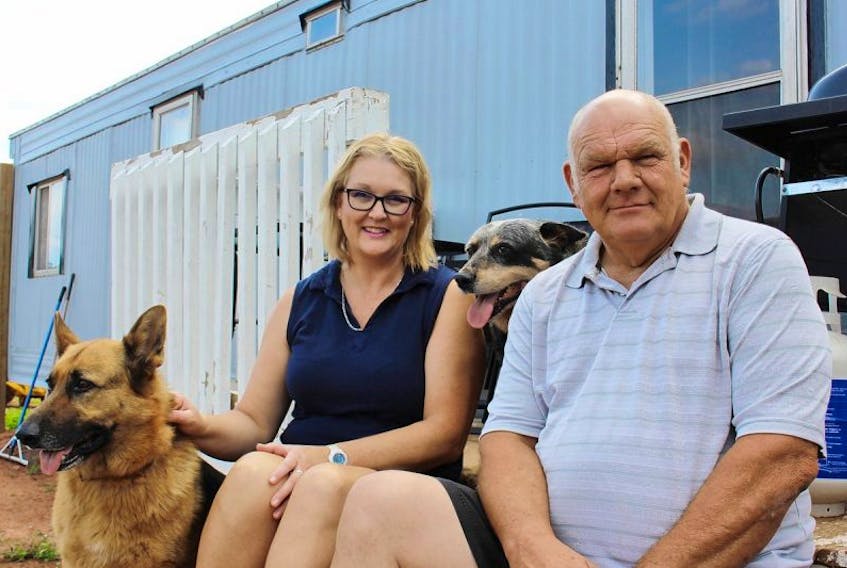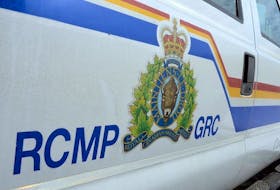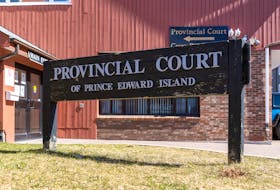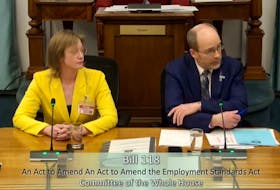Arsenault sat on his lawn as he watched firefighters scurry down from the roof of his home, seconds before the top floor windows exploded.
Remnants of the house and glass shards littered the property.
The fire took place on May 17, 2017. Two days later, a flare up caused a second fire, this time destroying what may have been salvaged.
Now, the couple is fighting their insurance company that says the value of the home is about $25,000 less than its insured value.
“We’ve gone through the stages of mourning our home. It was literally like the five stages of grief. Now we want to move on and start fresh,” said Pendergast.
Arsenault, a senior currently on disability pension after breaking his legs while working on the home, worked as a truck driver. Pendergast works for Canada Post.
In 2008, Arsenault had the home appraised for $70,000. He proceeded to get a mortgage of $55,000 and began working on the 50-plus-year-old house.
He had it insured with P.E.I. Mutual Insurance. Arsenault has paid annual premiums of $351 on an “actual cash value” policy.
After the fire, an appraiser from the insurance company came to the property and determined that the property was not worth its original value.
A few weeks after that, Arsenault and Pendergast received a package in the mail stating: “Our appraiser… had completed an appraisal on May 18, 2017, which indicates an Actual Cash Value at the time of the loss on your dwelling at $45,000.
The two appraisals in question were taken nine years apart. Since 2008, there has been a demographic shift in rural P.E.I., which caused market values to decrease. Due to these circumstances our offer for the actual cash value settlement of your dwelling remains at $45,000.”
Pendergast says it doesn’t seem right that living in rural P.E.I. can decrease the value of a home.
“It’s something that Islanders should know. If they live in a rural area they may want to know if they’re going to be able to get what they have paid for.”
Although Blair Campbell, the manager of P.E.I. Mutual, said he could not speak to specific cases, he did say nowhere in their policies will it cite rural locations as a reason for impacting the policy.
“We don’t say ‘because you live here, this is the amount you’re going to get’. That is not in our policy. But our policy says we will pay the cash value, which effectively is the market value in the case of a dwelling. And location does affect market value, but that is a real-estate value and comes from the market. Our policy dictates we will pay the market value and the market value can sometimes be dictated by location and condition.”
Other Issues
Pendergast, who has worked in the insurance industry, claims when the initial policy was put together there were multiple mistakes.
“The first one was the value of the content insurance for personal property that is in a house. Generally that value is supposed to equal 50 per cent of what you’re house value is. So if our house was valued at $70,000, the personal property should have been insured up to $35,000 not the $10,000 it was listed at on the policy.”
Campbell stated that when a policy is set up, the dwelling and personal property insurance is arranged by the client and the insurance agent.
“Generally the agent will provide as much insurance as the client is willing to purchase,” Campbell explained.
The second issue for Pendergast was the insurance value on the horse barn located on the property.
“It is listed as three buildings. The best way to describe it is like they insured a house, a front porch and a back porch. What are supposed to be these others buildings, don’t exist,” said Pendergast.
She added, “What’s more, 10 per cent of the policy goes to debris removal. If the home is worth $45,000, why are we getting $7,000 to remove debris? That’s not 10 per cent of what they say our home is worth, it’s 10 per cent of what we know our home to be worth.”
Last week Arsenault got a letter in the mail cancelling his policy, about two weeks before his policy would need to be renewed.
“The property insured under the above policy no longer meets our minimum underwriting standards. This is to notify you that the above policy will not be renewed and shall terminate on its expiry date,” stated the letter.
Campbell explained, “A policy of insurance is a mutual agreement between the insured and the insurer. The insured or the insurer can cancel it and when there is a major change, such as the property insured no longer exists, the policy can be cancelled or it may not be renewed.”
Arsenault and Pendergast are unhappy with how the situation has been handled.
“We haven’t gotten answers. We don’t know what has made the value go down and we were told we could not see the appraiser’s report,” said Arsenault.
“I feel deceived. Getting a piece of paper in the mail saying this is what my home is worth. It was a slap in the face to pay the premiums that it isn’t supposedly worth.”
Pendergast added, “When all of this is over we won’t have money to build a new house or even buy a new one. They’ve left us with nothing. We just want people to be aware of what can happen when you suffer a loss like this.”









